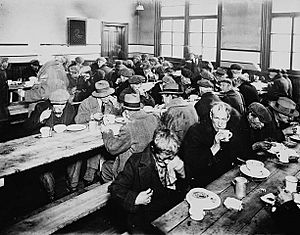Depression (economics) facts for kids
A depression is a long time when a country's economy is not working well. During a depression, many people lose their jobs. It is a much more serious type of recession. A depression can last for several years.
Besides high unemployment, depressions also hurt banks, trade, and manufacturing. Prices often fall, and it becomes harder to get credit (loans). Many businesses go bankrupt. A depression in one country can quickly spread to other countries around the world.
Contents
The Great Depression: A Global Crisis

The Great Depression (1929-1939) was the longest and deepest economic downturn in the history of the modern industrial world. It began after the U.S. stock market crash in 1929. Stock prices on Wall Street fell sharply from October 24 to October 29, 1929. This caused panic among investors, and millions lost their savings.
By 1933, nearly half of the banks in the United States had failed. Between 13 and 15 million Americans were unemployed. The start of World War II in Europe eventually helped to end the depression.
How the Depression Spread Worldwide
The Great Depression affected countries worldwide. Unlike earlier depressions that only hurt a few countries, this one was felt by almost all industrial nations. Africa, Asia, Australia, Europe, and North and South America all suffered.
Countries tried to protect their own economies by raising tariffs. These are taxes on goods they imported from other countries. This caused world trade to fall by about 30 percent. An estimate shows that 30 million people were unemployed worldwide by 1932.
Political Changes Caused by the Depression
The Great Depression had big political effects. As economies struggled, some people looked to strong leaders or even dictators to save their countries. For example, countries like Argentina and several in Central America had dictators.
In Germany, Italy, and Japan, a political idea called Fascism grew strong. This directly led to World War II. In the Soviet Union, the depression allowed Joseph Stalin to gain more power. He sent millions to labor camps, and many people died during his rule in the 1930s.
In Western countries like Canada, France, and Great Britain, one response was Welfare Capitalism. This meant governments started to play a bigger role in helping people and the economy.
Signs of a Modern Depression
As of 2013, some countries in Europe faced higher unemployment rates than during the Great Depression of the 1930s. Their Gross domestic product (GDP), which measures a country's economic output, was shrinking. Europe's financial crisis showed signs of getting worse.
While some government officials called it a recession, many economists were already calling it a depression. Because European countries use the same Euro currency, they cannot easily change the value of their own money. This means they cannot lower the price of their exports to make them more attractive to other countries. This makes it harder for them to achieve a balance of trade.
Images for kids
See also
 In Spanish: Depresión (economía) para niños
In Spanish: Depresión (economía) para niños


